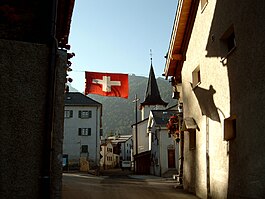Saint-Luc, Switzerland
Saint-Luc | |
|---|---|
 General view of Saint-Luc | |
| Coordinates: 46°13′N 7°36′E / 46.217°N 7.600°E | |
| Country | Switzerland |
| Canton | Valais |
| District | Sierre |
| Area | |
• Total | 31.9 km2 (12.3 sq mi) |
| Elevation | 1,655 m (5,430 ft) |
| Population (December 2008) | |
• Total | 312 |
| • Density | 9.8/km2 (25/sq mi) |
| Time zone | UTC+01:00 (Central European Time) |
| • Summer (DST) | UTC+02:00 (Central European Summer Time) |
| Postal code(s) | 3961 |
| SFOS number | 6247 |
| ISO 3166 code | CH-VS |
| Website | www SFSO statistics |
Saint-Luc is a village in the district of Sierre in the Swiss canton of Valais. An independent municipality before, it merged on 1 January 2009 with neighboring Ayer, Chandolin, Grimentz, Saint Jean and Vissoie to form the municipality of Anniviers.[1]
History
Saint-Luc is first mentioned in 1267 as Lus. In 1304 it was mentioned as Luc, which was the official name until 1904. The name Saint-Luc first appears around 1850.[2]
Coat of arms
The blazon of the village coat of arms is Azure, issuant from a Ribbon Or three Pine trees Vert trunked proper and an Ox passant Argent.[3]
Demographics
Saint-Luc has a population (as of December 2008[update]) of 312.[4]
Most of the population (as of 2000[update]) speaks French (265 or 83.1%) as their first language, German is the second most common (22 or 6.9%) and Portuguese is the third (16 or 5.0%). There are 8 people who speak Italian.[5]
Of the population in the village, 110 or about 34.5% were born in Saint-Luc and lived there in 2000. There were 87 or 27.3% who were born in the same canton, while 53 or 16.6% were born somewhere else in Switzerland, and 66 or 20.7% were born outside of Switzerland.[5]
As of 2000[update], there were 135 people who were single and never married in the village. There were 154 married individuals, 16 widows or widowers and 14 individuals who are divorced.[5]
There were 32 households that consist of only one person and 11 households with five or more people. In 2000[update], a total of 120 apartments (11.8% of the total) were permanently occupied, while 845 apartments (82.8%) were seasonally occupied and 55 apartments (5.4%) were empty.[6]
The historical population is given in the following chart:[2][7]

Politics
In the 2007 federal election the most popular party was the CVP which received 36.88% of the vote. The next three most popular parties were the SP (22.57%), the SVP (12.86%) and the Green Party (9.97%). In the federal election, a total of 176 votes were cast, and the voter turnout was 63.8%.[8]
Economy
There were 165 residents of the village who were employed in some capacity, of which females made up 42.4% of the workforce. In 2008[update] the total number of full-time equivalent jobs was 167. The number of jobs in the primary sector was 14, of which 3 were in agriculture and 11 were in forestry or lumber production. The number of jobs in the secondary sector was 14 of which 13 or (92.9%) were in manufacturing and 1 was in construction. The number of jobs in the tertiary sector was 139. In the tertiary sector; 14 or 10.1% were in the sale or repair of motor vehicles, 17 or 12.2% were in the movement and storage of goods, 67 or 48.2% were in a hotel or restaurant, 6 or 4.3% were in education.[9]
In 2000[update], there were 37 workers who commuted into the village and 72 workers who commuted away. The village is a net exporter of workers, with about 1.9 workers leaving the village for every one entering.[10]
Religion
From the 2000 census[update], 269 or 84.3% were Roman Catholic, while 25 or 7.8% belonged to the Swiss Reformed Church. Of the rest of the population, there was 1 individual who belongs to another Christian church. 21 (or about 6.58% of the population) belonged to no church, are agnostic or atheist, and 3 individuals (or about 0.94% of the population) did not answer the question.[5]
Education
In Saint-Luc about 120 or (37.6%) of the population have completed non-mandatory upper secondary education, and 47 or (14.7%) have completed additional higher education (either University or a Fachhochschule). Of the 47 who completed tertiary schooling, 48.9% were Swiss men, 31.9% were Swiss women, 14.9% were non-Swiss men.[5]
As of 2000[update], there were 67 students from Saint-Luc who attended schools outside the village.[10]
References
- ^ Amtliches Gemeindeverzeichnis der Schweiz published by the Swiss Federal Statistical Office Template:De icon accessed 19 July 2011
- ^ a b Saint-Luc in German, French and Italian in the online Historical Dictionary of Switzerland.
- ^ Flags of the World.com accessed 22-September-2011
- ^ Swiss Federal Statistical Office - Superweb database - Gemeinde Statistics 1981-2008 Template:De icon accessed 19 June 2010
- ^ a b c d e STAT-TAB Datenwürfel für Thema 40.3 - 2000 Template:De icon accessed 2 February 2011
- ^ Swiss Federal Statistical Office STAT-TAB - Datenwürfel für Thema 09.2 - Gebäude und Wohnungen Template:De icon accessed 28 January 2011
- ^ Swiss Federal Statistical Office STAT-TAB Bevölkerungsentwicklung nach Region, 1850-2000 Template:De icon accessed 29 January 2011
- ^ Swiss Federal Statistical Office, Nationalratswahlen 2007: Stärke der Parteien und Wahlbeteiligung, nach Gemeinden/Bezirk/Canton Template:De icon accessed 28 May 2010
- ^ Swiss Federal Statistical Office STAT-TAB Betriebszählung: Arbeitsstätten nach Gemeinde und NOGA 2008 (Abschnitte), Sektoren 1-3 Template:De icon accessed 28 January 2011
- ^ a b Swiss Federal Statistical Office - Statweb Template:De icon accessed 24 June 2010
External links
- Official website Template:Fr icon
 Media related to Saint-Luc at Wikimedia Commons
Media related to Saint-Luc at Wikimedia Commons




